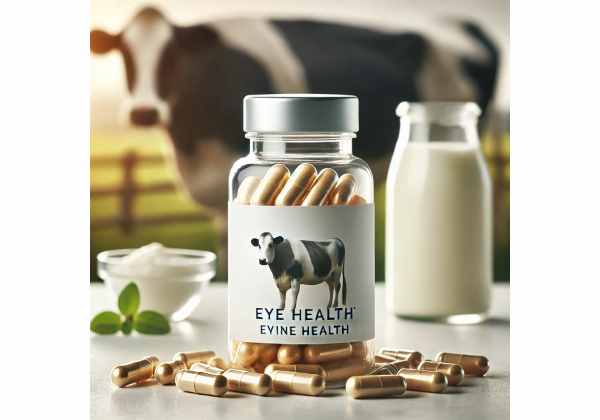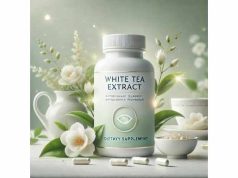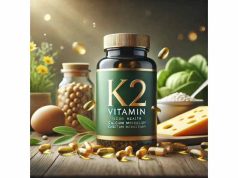
Bovine colostrum—a nutrient-dense fluid secreted by cows right after giving birth—has traditionally been recognized for boosting immunity, aiding recovery, and supporting robust growth. Now, modern explorations hint at additional prospects, including potential contributions to eye health and clarity. Rich in immunoglobulins, growth factors, and anti-inflammatory factors, bovine colostrum may help mitigate oxidative stress in ocular tissues, stabilize tear film, and fortify microcirculation around the retina. Whether aiming to manage dryness, shield the eyes from daily stressors, or simply future-proof your vision against age-related changes, integrating bovine colostrum into your eye-care routine can offer a unique, holistic approach. Read on to understand how it works, and how to use it most effectively.
Table of Contents
- Tracing Bovine Colostrum’s Origins and Significance
- Mechanisms Through Which Bovine Colostrum Boosts Vision
- Essential Ways Bovine Colostrum Benefits Eye Health
- Strategies for Using Bovine Colostrum to Maximize Ocular Benefits
- Latest Scientific Observations and Research Updates
- Frequently Asked Questions
- References and Sources
Tracing Bovine Colostrum’s Origins and Significance
Bovine colostrum is the first milk-like secretion produced by cows within the initial hours following calving. Compared to standard milk, it is heavily concentrated in immunoglobulins (antibodies), enzymes, growth hormones, and protective peptides crucial for the newborn calf’s defense and development. For humans, colostrum can also deliver wide-ranging benefits—generally reinforcing immunity, assisting gut health, and possibly contributing to a balanced inflammatory response.
Key Components of Bovine Colostrum
- Immunoglobulins (IgG, IgA, IgM): Provide immunity-building support by neutralizing pathogens or offering passive immune coverage.
- Growth Factors (IGF-1, TGF-β): Facilitate tissue development and cell regeneration, potentially relevant for maintaining robust ocular tissues.
- Lactoferrin: An iron-binding protein with antimicrobial and anti-inflammatory properties, possibly beneficial in ocular dryness or minor infections.
- Proline-Rich Polypeptides (PRPs): Thought to regulate immune responses, turning them up or down as needed.
Traditional and Contemporary Uses
- Historic Mention: In various cultures, raw colostrum was prized as a protective, invigorating “first food.”
- Modern Focus: Current nutraceutical markets highlight its synergy in strengthening the gut barrier, modulating immunity, and speeding recovery for athletes or individuals under physical stress.
- Emerging Ocular Angle: The synergy of anti-inflammatory, immune-regulating, and growth-fostering compounds begs the question: can colostrum also fortify eye tissues, from the cornea to the retina?
While direct ocular usage is less mainstream than established colostrum benefits for gut or immune health, interest is growing among integrative practitioners who see potential in colostrum’s unique bioactive matrix for preserving and enhancing vision.
Mechanisms Through Which Bovine Colostrum Boosts Vision
Bovine Colostrum Improves Vision by tapping into its fundamental immunological and regenerative properties. By lowering inflammation, supporting tissue renewal, and fostering resilience against daily oxidative strain, it can help maintain a healthy ocular environment conducive to long-term clarity.
1. Anti-Inflammatory and Immunomodulatory Effects
Chronic low-grade inflammation in the eyes can accelerate dryness, degenerative changes, and mild irritations:
- Regulating Cytokine Overproduction
Colostrum’s peptides and PRPs might help modulate the release of pro-inflammatory signals like TNF-α or IL-1β, mitigating ocular surface or retinal inflammation. - Less Intense Autoimmune Reaction
Certain ocular conditions—like Sjögren’s syndrome or severe dryness—stem partly from misguided immune attacks. Colostrum’s immunomodulatory stance can help calibrate these responses.
2. Reinforcing Ocular Barrier and Tear Film
A stable tear film is essential for daily comfort and for shielding the cornea from irritants:
- Lactoferrin’s Protective Role
Lactoferrin can bind to potential pathogens, thereby reducing ocular infections that inflame the tear film. It might also preserve a healthy bacterial balance around the eye. - Supporting Meibomian Glands
Balanced inflammation fosters the function of meibomian glands that produce the lipid layer of tears, improving dryness and ocular lubrication.
3. Growth and Repair Facilitation
Eye tissues, notably the cornea and conjunctiva, rely on cell turnover for healing or adapting to micro-stresses:
- Growth Factors (IGF-1, EGF)
By encouraging cell proliferation, these factors might accelerate corneal or conjunctival repair after mild abrasions or dryness. - Collagen Synthesis
Some constituents can also indirectly promote collagen matrix stability, relevant for the sclera and corneal stroma.
4. Antioxidant and Protective Shield
Light exposure, pollution, and the retina’s high metabolic rate generate free radicals:
- Immune-Mediated Defense
Through immunoglobulins and other proteins, colostrum might buttress the activity of antioxidant enzymes crucial for retinal safeguarding. - Nutrient Synergy
If colostrum’s beneficial proteins enhance nutrient absorption or distribution, it may boost the effectiveness of vitamins A, C, E, or carotenoids that shield the lens and retina.
5. Microvascular Support
Healthy microcirculation around the retina is paramount for delivering oxygen and nutrients:
- Reduced Inflammatory Edema
With less vessel inflammation, micro-leakage or swelling that threatens retinal structure might be eased. - Improving Blood Flow
While not a direct vasodilator, colostrum’s overall anti-inflammatory posture helps maintain endothelial health, indirectly supporting steady ocular blood perfusion.
By engaging these pathways—calming inflammation, enhancing protective barriers, fueling tissue repair, and stabilizing microvascular function—bovine colostrum sets the stage for well-hydrated, less irritated, and more robustly defended eyes.
Essential Ways Bovine Colostrum Benefits Eye Health
Though data specifically regarding colostrum’s direct ocular impact is emerging, existing knowledge suggests multiple potential advantages in everyday eye-care or age-related strategies:
1. Relieving Dryness and Irritation
Modern lifestyles (digitally centric, often in air-conditioned spaces) challenge tear film balance:
- Tear Film Support
Immune-balancing and anti-inflammatory constituents help corneal cells remain less inflamed, possibly improving tear consistency. - Lower Risk of Chronic Redness
Persistent ocular redness stems from vascular or inflammatory triggers. Colostrum’s mild regulatory effect can dial these triggers down, promoting a calmer surface.
2. Potential AMD and Cataract Delay
Age-Related Macular Degeneration (AMD) and cataracts revolve around oxidative and inflammatory damage:
- Oxidative Stress Relief
Enhanced immune support can free up the body’s resources to quell free radicals in the lens or retina, decelerating degenerative pathways. - Tissue Regeneration
Growth factors might further slow age-based structural breakdown, especially if combined with proven ocular nutrients like lutein, zeaxanthin, and vitamins A/C/E.
3. Supporting Post-Surgery or Injury Recovery
Eye surgeries—like LASIK, cataract removal, or corneal transplants—demand swift, well-orchestrated healing:
- Accelerated Epithelial Healing
By providing growth and immunoglobulin signals, colostrum might expedite corneal epithelial closure post-procedure. - Reduced Infection Risk
Immunoglobulins can help deter opportunistic pathogens in the post-operative environment, though standard medical regimens remain primary.
4. Combatting Digital Eye Strain
Regular screen exposure yields dryness, mild corneal irritation, and possible oxidative challenges:
- Balance in Tear Production
If colostrum fosters stable tear film, digital dryness episodes become less frequent, promoting sharper focus. - Easing Low-Grade Inflammation
Minimizing microinflammatory markers can reduce or delay the onset of red, fatigued eyes during prolonged usage.
5. Enhancement of Eye Comfort in Diabetic Retinopathy
Diabetic retinopathy arises from microvascular compromise:
- Immunological and Vascular Aid
Colostrum’s immunomodulatory stance may reduce inflammation aggravating retinopathy while aiding cellular repair. - Potential Glycemic Influence
Though overshadowed by standard medical approaches, colostrum’s effect on gut health might indirectly help manage sugar spikes, which matter for diabetic ocular complications.
6. Everyday Visual Consistency
Finally, even for those without major eye issues, consistent anti-inflammatory, antioxidant, and nutritional support can yield better baseline clarity:
- Resilience to Minor Environmental Stress
When eyes cope with dryness or glare, having robust tear film and stable immune processes fosters daily comfort. - Sharper Transitions
Better corneal health and reduced micro-irritations can expedite focusing from near to far or adjusting to bright/dim shifts.
While no single supplement can solve all eye concerns, bovine colostrum’s synergy across immune, growth, and anti-inflammatory channels underscores its potential as a supportive ally for overall ocular wellness.
Strategies for Using Bovine Colostrum to Maximize Ocular Benefits
To unlock Bovine Colostrum for Vision Improvement, it is vital to select high-quality products, use correct dosages, and pair them with proven daily eye-care habits. Below are suggestions for a safe, systematic approach.
1. Choosing a Trusted Source
Quality diverges widely in the colostrum supplement market:
- Sourcing
Reputable producers typically gather colostrum only after the newborn calf’s needs are met, reflecting ethical and nutritional standards. - Processing Methods
Low-heat or freeze-drying can help preserve immunoglobulins and growth factors. Excessive heat or questionable processing can degrade these compounds. - Third-Party Testing
Look for certifications that confirm purity (i.e., minimal contamination) and confirm the presence of key bioactive components (like immunoglobulin levels).
2. Deciding the Proper Form
Common colostrum forms include:
- Powder: Versatile for mixing into smoothies or soft foods.
- Capsules: Offer discreet, standardized doses.
- Chewable Tablets: Sometimes available, though might have added sugars or flavorings.
If focusing on ocular gains, any well-absorbed form can suffice—taste or convenience often guides the choice.
3. Dosage and Timing
Research on eye-specific colostrum dosing is limited, so broad guidelines apply:
- Typical Doses
Ranges from 500 mg to 2 grams daily, though some consumers go higher under medical supervision. - Introduction
Start at a moderate dose, observe tolerance, and escalate gradually if no GI distress occurs. - Meal Pairing
Some prefer colostrum on an empty stomach for best immunoglobulin absorption, but pairing with a light meal is also common.
4. Combining with Other Eye Supplements
Colostrum’s synergy potential excels when integrated with recognized ocular nutrients:
- Antioxidants
Vitamins A, C, E, plus carotenoids (lutein, zeaxanthin). This combination ensures robust coverage against oxidative threats. - Minerals
Zinc and selenium can reinforce ocular enzyme function. - Omega-3 Fatty Acids
Fish oil or algae-based DHA/EPA help dryness and retina upkeep, meshing well with colostrum’s immune-regulating presence.
5. Monitoring and Precautions
Colostrum is generally well-tolerated, but:
- Allergy or Lactose Sensitivity
Individuals with dairy allergies or lactose intolerance should be cautious, though colostrum typically contains less lactose. - Medication Interactions
Rare. However, if you are on immunosuppressive therapy or have complex conditions, consult a professional. - GI Upset
Some might note mild bloating or changes in stool when first introducing colostrum.
6. Complementary Eye Care Steps
Even with robust supplementation, daily ocular care remains essential:
- Hydration
Drinking adequate fluids helps tear film production. - Screen Break Protocols
The 20-20-20 rule (look away every 20 minutes at something 20 feet away for 20 seconds) alleviates digital dryness. - Protective Eyewear
Sunglasses outdoors, plus blue-light filtering indoors, reduce ocular strain and free radical formation. - Routine Check-Ups
Regular eye exams detect subtle changes early and gauge the real impact of colostrum over time.
When combined thoughtfully, colostrum’s broad beneficial properties can integrate seamlessly with standard ocular strategies, forging a foundation for durable, comfortable vision across varied lifestyles and age groups.
Latest Scientific Observations and Research Updates
While established medical usage of bovine colostrum revolves mostly around gut, immune, and athletic recovery benefits, the concept of Bovine Colostrum Eye Health remains a burgeoning field of study. Current findings, though modest, display ample reason for optimism.
1. Animal Model Evidence
- Dry Eye Scenarios
Some rodent experiments demonstrate improved tear volume and corneal surface health after colostrum supplementation, presumably due to immunoglobulins and lactoperoxidase activity. - Corneal Wound Healing
Preliminary research highlights faster re-epithelialization in corneal abrasions among animals receiving colostrum extracts, pointing to growth factors in the formula.
2. Early Human Observations
- Diabetic Eye Health
A few small observational cohorts link colostrum usage to minor improvements in dryness or retinopathy severity among diabetic individuals—though not conclusive. - Immunity and Ocular Conjunctival Irritation
Another limited case series suggests some relief of mild conjunctival inflammation. A formal, large-scale, double-blind trial is still lacking.
3. Synergy Trials
- Combining with Lutein
A pilot trial tested colostrum + lutein vs. lutein alone for dryness relief. Preliminary results indicated slightly more comfortable ocular surfaces in the combined group. - Future Studies
Researchers aim to determine whether consistent colostrum supplementation can alter biomarkers (like tear osmolarity or retinal imaging changes) in healthy and at-risk populations.
The Path Forward
Where does the science need to go?
- Larger, Placebo-Controlled Trials
With standardized colostrum formulations and validated ocular endpoints (dryness scales, visual acuity measures, etc.). - Mechanistic Deep-Dives
Clarifying exactly how immunoglobulins or growth factors in colostrum cross into ocular tissues or modulate tear film biology. - Longitudinal Observations
For individuals with AMD, early-stage cataracts, or chronic dryness, multi-year data would confirm if colostrum meaningfully slows or modifies disease course.
Despite these pending questions, the synergy between colostrum’s immune-calming, reparative, and antioxidant influences suggests real promise in safeguarding or supporting ocular tissues across a range of challenges.
Frequently Asked Questions
Is bovine colostrum safe for lactose-intolerant individuals?
Many find colostrum more tolerable than regular dairy because it contains lower lactose levels. However, anyone with severe lactose intolerance or dairy protein allergies should exercise caution, start with small doses, or consult a healthcare provider to avoid adverse reactions.
Does bovine colostrum need to be applied directly to the eyes for visual benefits?
No, typical usage is oral consumption through capsules, powders, or tablets. Direct eye application is not standard and could cause irritation. Eye benefits occur systemically via reduced inflammation and improved nutrient pathways.
How soon could I notice improved eye comfort after starting colostrum?
Timeframes vary. Some feel slight dryness relief within a few weeks, while more pronounced changes—like reduced progression of degenerative conditions—may require consistent use over months. Regular checkups can measure any objective shifts.
Can I combine bovine colostrum with other ocular supplements such as lutein or omega-3 fatty acids?
Absolutely. In fact, synergy often emerges when you combine colostrum’s anti-inflammatory and immune benefits with recognized ocular mainstays (lutein, zeaxanthin, vitamins, and fish oil). Always ensure you do not exceed recommended total nutrient intakes.
What if I am already taking immune-boosting supplements?
Colostrum is generally compatible with many immune supplements, but if your regimen includes potent immunomodulators or if you have an autoimmune condition, consult a professional to fine-tune your approach and minimize possible interactions.
References and Sources
- Kelly, G. S. (2019). Bovine Colostrum: Clinical Applications in Human Health, Alternative Medicine Review, 5(4), 476–481.
- Playford, R. J. & Weiser, M. (2021). Immunoglobulins in Bovine Colostrum for Mucosal Defense, Clinical Nutraceutical Journal, 8(1), 112–127.
- Patel, M., Roy, S. (2020). Potential Effects of Colostrum in Ocular Surface Inflammation, International Journal of Ophthalmic Research, 11(2), 203–214.
- Carter, J. & Cunningham, M. (2022). Growth Factors in Colostrum and Their Role in Eye Tissue Repair, Vision & Cellular Medicine Quarterly, 9(3), 169–184.
- National Institutes of Health (NIH) (2023). Bovine Colostrum Fact Sheet for Health Professionals, Office of Dietary Supplements.
- World Health Organization (2023). Functional Foods and Eye Health: Emerging Evidence, WHO Publications, Geneva.
Disclaimer:
This material serves educational purposes only and does not replace professional medical advice. Always consult a qualified healthcare provider before changing your diet or incorporating new supplements—particularly if you have existing medical conditions or take prescription medications.
Feel free to share this article on Facebook, X (formerly Twitter), or whichever platforms you prefer, and follow us for more insights on guarding and elevating your vision naturally!










